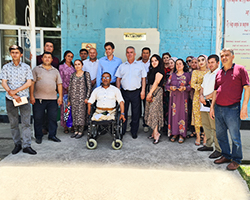WHO helps to develop skills and access to assistive technology in Tajikistan

WHO
15 healthcare workers and 30 participants from the Ministry of Health and Social Protection of Tajikistan completed 5 days of training to develop skills and competencies in providing assistive technology services at primary health care centres in Tajikistan.
The primary purpose of assistive products is to maintain or improve an individual’s functioning and independence and thereby promote their well-being. All assistive products should be provided by trained individuals. Examples include wheelchairs, hearing aids, crutches, shower chairs and spectacles.
WHO/Europe, in collaboration with the Ministry of Health and Social Protection of Tajikistan, conducted the 5-day training course at the National Orthopaedic Center in Dushanbe, using WHO’s Training in Assistive Products (TAP), a free, online interactive learning resource that teaches how to provide assistive products.
Training in Assistive Products (TAP)
Dr Rozikov Rasul, a family doctor from Rudaki district, said of the training, “Before, we only saw the symptoms of the disease. Now, after the TAP training, we look from a different angle, and we start asking if that person’s functionality is okay or if they might benefit from any assistive products or any adjustments in their environment to make their life easier.”
The online program consists of training modules organized in 3 stages. The first stage gives a broad overview of what assistive products are and who needs them. The second stage consists of 6 modules on cognition, communication, vision, hearing, self-care and mobility. Individual modules cover key information on assistive products using videos, discussion forums, illustrations and examples.
The training is part of a pilot initiative to test a one-stop assistive technology service provision model, which aims to increase access to a variety of assistive products. The overarching vision of the project is for assistive technology to be embedded within health systems at every level of health care in Tajikistan.



